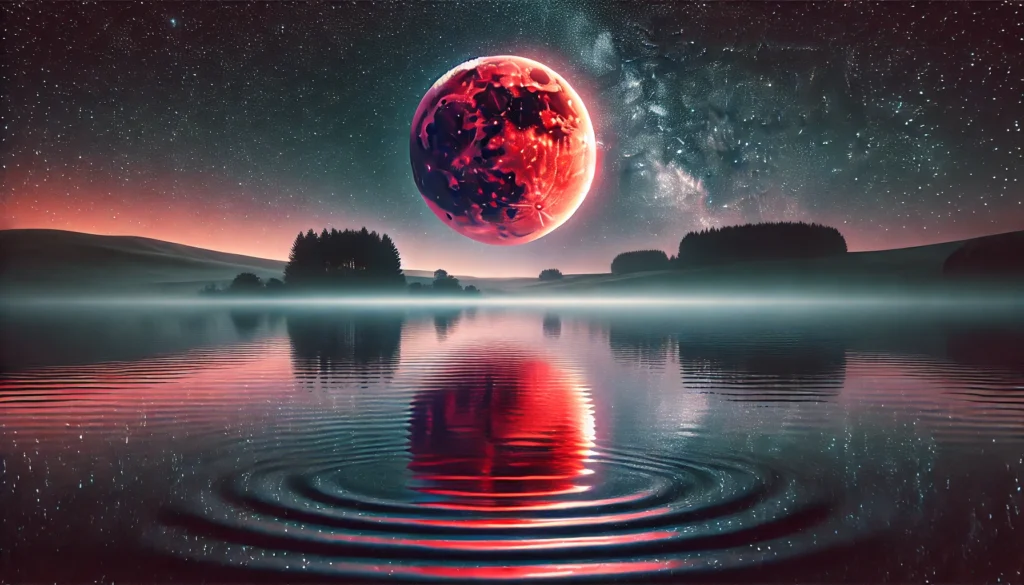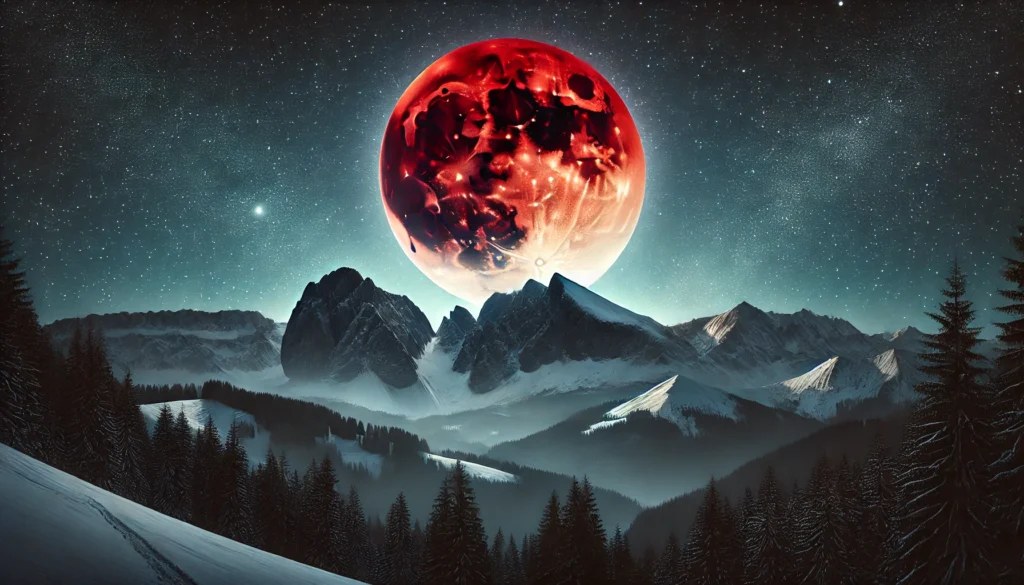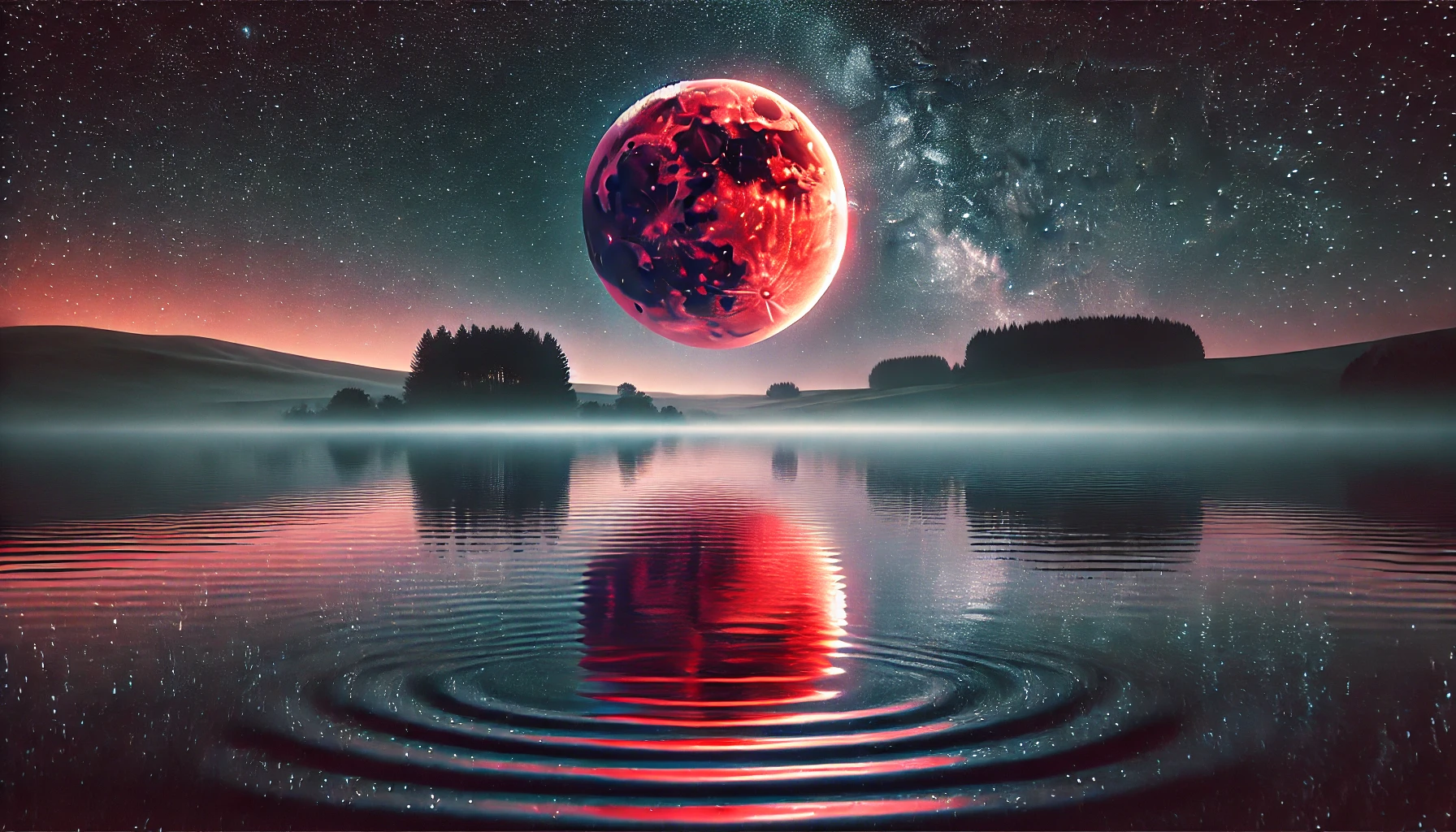The night sky has always fascinated humankind, offering a celestial display that inspires myths, scientific inquiries, and even religious interpretations. One of the most awe-inspiring spectacles witnessed by skywatchers is the Blood Moon. This eerie and dramatic event has intrigued astronomers and enthusiasts for centuries. But what exactly is a Blood Moon, and why does it occur? This article delves deep into the science, history, myths, and cultural significance of this breathtaking lunar phenomenon.
What Is a Blood Moon?
A Blood Moon refers to the reddish hue that the Moon takes on during a total lunar eclipse. This occurs when the Earth aligns directly between the Sun and the Moon, blocking direct sunlight from reaching the lunar surface. Instead of going completely dark, the Moon appears red due to a process known as Rayleigh scattering—the same phenomenon responsible for colorful sunrises and sunsets.
During a total lunar eclipse, sunlight passes through Earth’s atmosphere, which scatters shorter wavelengths (blue and violet light) while allowing longer wavelengths (red and orange) to bend toward the Moon. As a result, the Moon glows in shades ranging from deep red to burnt orange, depending on atmospheric conditions such as dust, pollution, or volcanic activity.
Table of Contents
How Often Does a Blood Moon Occur?.
Tetrads: A Series of Blood Moons.
Historical and Cultural Interpretations of the Blood Moon.
Modern Superstitions and Conspiracies.
Exciting stories & Myths associated with Blood Moon.
Best Ways to Observe a Blood Moon.
How Often Does a Blood Moon Occur?
Unlike a solar eclipse, which is rare for any given location, total lunar eclipses are more common. On average, a Blood Moon occurs twice every three years. However, the frequency varies depending on the cycles of lunar eclipses. The phenomenon only happens during a full moon phase when all three celestial bodies—Earth, Moon, and Sun—are in perfect alignment.
Tetrads: A Series of Blood Moons
Sometimes, a series of four consecutive total lunar eclipses, known as a tetrad, can occur within a span of two years. This is a relatively rare event and often fuels speculation about its significance in various cultures and religious prophecies.
Types of Lunar Eclipses and Their Impact on the Blood Moon
There are three primary types of lunar eclipses, each affecting how prominent the Blood Moon appears:
- Total Lunar Eclipse – The entire Moon is covered by Earth’s umbra (the darkest part of its shadow), leading to a dramatic, fully red-hued Moon.
- Partial Lunar Eclipse – Only a part of the Moon enters Earth’s umbra, creating a mix of bright and shadowed regions.
- Penumbral Lunar Eclipse – The Moon passes through the Earth’s penumbra (the outer shadow), resulting in a subtle dimming but without the deep red effect of a total lunar eclipse.
Scientific Significance of a Blood Moon
From an astronomical perspective, a Blood Moon serves as a fascinating display of celestial mechanics. It provides scientists with a unique opportunity to study Earth’s atmosphere. By analyzing the light reflected from the Moon during an eclipse, researchers can gain insights into atmospheric composition, climate patterns, and even pollution levels.

NASA and other space agencies often use lunar eclipses to test instruments and study how the Earth’s atmosphere influences light transmission, which is helpful in planetary research and space exploration.
Historical and Cultural Interpretations of the Blood Moon
Throughout history, Blood Moons have been associated with omens, prophecies, and significant historical events. Various cultures have attached different meanings to this celestial occurrence.
Ancient Civilizations and Mythology
- The Incas believed that a Blood Moon signified that a jaguar was attacking the Moon, and they would make noise to scare it away.
- The Chinese viewed lunar eclipses as celestial battles, often interpreting them as a dragon devouring the Moon.
- Native American Tribes saw Blood Moons as a warning or a time of transformation.
Religious and Biblical Connections
Several religious texts mention Blood Moons as signs of significant change:
- The Bible, particularly in the Book of Joel and Revelation, refers to the Moon turning blood-red before the “great and terrible day of the Lord.”
- Some Christian groups believe that tetrads align with prophetic biblical events.
- In Islamic tradition, lunar eclipses are considered moments for prayer and reflection.
Modern Superstitions and Conspiracies
In the modern era, Blood Moons continue to fuel superstitions and conspiracy theories. Some people associate them with natural disasters, economic turmoil, or global shifts. Despite the lack of scientific backing, such beliefs persist, especially when multiple Blood Moons occur in close succession.
Exciting stories & Myths associated with Blood Moon
Here are a few fascinating stories associated with the Blood Moon:
1. The Incan Jaguar Myth
The Inca civilization believed that a jaguar was attacking the Moon during a lunar eclipse. To scare the jaguar away, they would bang drums, shout, and create loud noises, fearing that the beast would next attack Earth if it devoured the Moon.
2. The Chinese Celestial Dragon
In ancient China, people thought that a dragon was eating the Moon during a Blood Moon. To combat this celestial beast, villagers would bang pots and shoot arrows into the sky to drive the dragon away, ensuring the Moon’s safe return.
3. The Prophecy of the Four Blood Moons
Christian prophecy speakers, such as John Hagee, linked a series of four consecutive Blood Moons (a tetrad) to significant events in Jewish and world history. Some claimed these eclipses signified the fulfillment of biblical prophecies.
4. The Viking Belief in Sky Wolves
The Norse mythology spoke of Hati and Sköll, two wolves chasing the Sun and Moon. A Blood Moon was seen as a sign that Hati had caught the Moon, prompting Vikings to make noise to free it.
5. The Cherokee Story of the Blood Moon’s Renewal
For the Cherokee tribe, the Blood Moon represented transformation and renewal. They saw it as a time for reflection, fasting, and connecting with ancestral spirits.

6. The Hindu Myth of Rahu Swallowing the Moon
In Hindu mythology, the demon Rahu was beheaded by the god Vishnu while trying to drink the elixir of immortality. His head, now immortal, takes revenge by occasionally swallowing the Sun or Moon—causing an eclipse. However, since he has no body, the Moon reappears soon after. Hindus often chant mantras and take a ritual bath during a Blood Moon to cleanse negative energies.
7. The Mesopotamian Death Omen
Ancient Babylonians and Assyrians saw lunar eclipses as omens of doom, especially for their kings. They believed that a Blood Moon predicted the death of a ruler. To counteract this, they would place a substitute king on the throne during an eclipse, allowing the real king to stay safe until the event passed.
8. The Mayan Belief in the Moon Being Attacked
The Maya civilization believed that a giant celestial beast was attacking the Moon during a lunar eclipse. Pregnant women were especially fearful, as they thought the Blood Moon could harm unborn children. To protect themselves, they used obsidian knives, painted red crosses on their stomachs, and made loud noises to scare the creature away.
9. The African Batammaliba Tribe’s Call for Peace
The Batammaliba people of Togo and Benin have a beautiful legend about the Blood Moon. They believe that during an eclipse, the Sun and Moon are fighting. Instead of fearing it, they take this time to reconcile with enemies, resolve conflicts, and restore peace within their communities.
10. The Filipino “Laho” Monster
In Philippine folklore, a Blood Moon was caused by a mythical serpent or dragon called “Laho”, which was believed to swallow the Moon. To prevent the Moon from disappearing forever, Filipinos would shout, light fires, and bang drums or gongs to scare the creature away.
11. The Korean Dogs of Eclipse
Korean folklore speaks of bulgae, mythical dogs sent by an evil ruler to steal the Sun and Moon. However, each time they tried, they failed—either burning their mouths on the Sun or getting frozen by the Moon’s coldness. A lunar eclipse was thought to be one of these failed attempts, and people performed rituals to ensure the Moon’s return.
12. The Aztec Prophecy of Disaster
The Aztecs believed that a Blood Moon signaled impending doom, war, or disaster. They associated it with their moon goddess Coyolxauhqui, who was dismembered by her brother, the Sun god Huitzilopochtli. Fearing the worst, Aztec warriors would perform ritual sacrifices to appease the gods during an eclipse.
13. The Islamic View of Lunar Eclipses
In Islamic tradition, lunar eclipses, including Blood Moons, are seen as a reminder of God’s greatness rather than a supernatural omen. The Prophet Muhammad encouraged Muslims to perform special prayers called “Salat-al-Khusuf” and seek forgiveness during the event.
14. The Japanese Red Moon as a War Signal
Japanese samurai believed that a red Moon was a sign of approaching war or conflict. If an army saw a Blood Moon before battle, it was taken as an omen of great bloodshed to come. Some warriors even planned their attacks around these celestial events.
15. The Native American “Time of Change”
Many Native American tribes viewed the Blood Moon as a period of transformation. Some, like the Lakota, believed it was a sign of new beginnings, while others, like the Apache, saw it as a time to stay indoors and reflect to avoid bad luck.
16. The Hawaiian Goddess Hina’s Warning
In Hawaiian legend, the goddess Hina, who controls the Moon, sends warnings through lunar eclipses. If the Moon turned red, it was a sign that people had angered the gods, and they needed to make offerings or correct their ways.
17. The Siberian Bear Spirit Eclipse
The Evenki people of Siberia believed that a giant bear spirit tried to swallow the Moon during an eclipse. To stop the bear, shamans would perform rituals and sing chants to restore balance.
18. The Cambodian Blood Moon Dance
Ancient Cambodians believed that a Naga (serpent deity) was responsible for the Blood Moon. They performed a special “Moon Dance” ritual to honor the spirits and restore cosmic harmony.
19. The European Medieval Fear of Blood Moons
During the Middle Ages, Europeans feared the Blood Moon as a sign of witchcraft, plagues, or the Devil’s presence. Some even believed it marked the beginning of the apocalypse, leading to widespread panic and prayer gatherings.
20. The Mongolian Eclipse Warriors
Mongolian tribes believed that lunar eclipses were battles between good and evil spirits. Warriors would paint their faces red and shoot arrows at the Moon to help the good spirits win.
These myths and legends highlight the universal wonder and fear associated with Blood Moons across different civilizations.
Best Ways to Observe a Blood Moon
For skywatchers, witnessing a Blood Moon is an unforgettable experience. Here are some tips to get the best view:
- Find a Dark Location – Light pollution can diminish visibility, so head to a place away from city lights.
- Check the Lunar Calendar – Use astronomy apps or NASA’s eclipse schedule to know when the next Blood Moon will occur in your region.
- Use Binoculars or a Telescope – While a Blood Moon is visible to the naked eye, magnifying equipment enhances the experience.
- Take Photos – A DSLR camera with a zoom lens or even a smartphone with manual settings can capture stunning images.
- Join an Astronomy Group – Many observatories and local astronomy clubs host events during lunar eclipses, offering telescopes and expert guidance.
Upcoming Blood Moons and Their Importance
If you’re eager to witness this celestial event, keep an eye on upcoming Blood Moons. NASA and astronomical organizations regularly publish schedules predicting lunar eclipses for the next several years. These predictions help enthusiasts prepare and plan viewing events well in advance.

Top 25 FAQs About Blood Moon
1. What is a Blood Moon?
A Blood Moon is a total lunar eclipse where the Moon appears red due to Earth’s atmosphere scattering sunlight.
2. Why does the Moon turn red during a lunar eclipse?
The red color is caused by Rayleigh scattering, where Earth’s atmosphere filters out blue light and lets red wavelengths reach the Moon.
3. How often does a Blood Moon occur?
On average, a Blood Moon happens twice every three years.
4. Is a Blood Moon the same as a total lunar eclipse?
Yes, a Blood Moon is another term for a total lunar eclipse.
5. Can a Blood Moon predict natural disasters?
No scientific evidence links Blood Moons to natural disasters.
6. Is a Blood Moon dangerous?
No, a Blood Moon is a natural and harmless phenomenon.
7. Do Blood Moons affect human behavior?
There is no scientific proof that Blood Moons influence human behavior.
8. Can you see a Blood Moon with the naked eye?
Yes, Blood Moons are visible without special equipment.
9. When is the next Blood Moon?
Check NASA’s lunar eclipse calendar for upcoming dates.
10. Do Blood Moons have religious significance?
Many religious texts and traditions reference Blood Moons as significant omens.
11. Can a Blood Moon be seen from anywhere on Earth?
No, visibility depends on location, weather, and time zone.
12. How long does a Blood Moon last?
A total lunar eclipse can last from 30 minutes to over an hour.
13. Does the Moon always turn the same shade of red?
No, atmospheric conditions affect the intensity and color.
14. Can a Blood Moon occur on any full moon?
No, it only happens when the Earth, Moon, and Sun align perfectly.
15. Do animals react differently during a Blood Moon?
Some nocturnal animals may behave differently due to the change in brightness.
16. Are Blood Moons more common than solar eclipses?
Yes, they occur more frequently and are visible to more people.
17. What is the difference between a Blood Moon and a Supermoon?
A Supermoon appears larger due to its proximity to Earth, while a Blood Moon is caused by an eclipse.
18. Can you photograph a Blood Moon with a smartphone?
Yes, using manual settings and a tripod helps capture better images.
19. Has a Blood Moon ever coincided with major historical events?
Some historical events have coincided with Blood Moons, fueling myths.
20. Do Blood Moons affect tides?
Tides are influenced by the full moon phase, but not directly by the color change.
21. How can I prepare to watch a Blood Moon?
Check eclipse schedules, find a dark spot, and bring binoculars or a telescope.
22. Is it possible to predict Blood Moons centuries in advance?
Yes, astronomers can calculate lunar eclipses far into the future.
23. Do other planets experience Blood Moons?
Lunar eclipses occur on other planets with moons, but they appear different.
24. Can I view a Blood Moon through a telescope?
Yes, a telescope enhances the details and colors of the Moon.
25. What is the rarest type of lunar eclipse?
A central lunar eclipse, where the Moon passes through the darkest part of Earth’s shadow.
Conclusion
The Blood Moon has captivated humanity for centuries, inspiring scientific curiosity, cultural traditions, and mystical beliefs. This striking celestial event, caused by the Earth’s shadow filtering sunlight onto the Moon, has been interpreted in various ways across civilizations. While science explains the Blood Moon as a natural result of planetary alignments and atmospheric refraction, ancient cultures often saw it as an omen of change, divine messages, or supernatural battles between cosmic forces.
From the Inca jaguar and Chinese celestial dragon to biblical prophecies and modern conspiracy theories, the Blood Moon has been linked to both fear and reverence. Some viewed it as a harbinger of disaster, while others saw it as a symbol of renewal and transformation. Even today, many people remain fascinated by its mysterious beauty and spiritual significance.
Scientifically, the Blood Moon serves as an important tool for astronomers, offering insights into Earth’s atmosphere and celestial mechanics. Space agencies like NASA study the light bending through our planet’s atmosphere to understand climate patterns and even improve space exploration techniques. The predictable nature of lunar eclipses has also allowed astronomers to calculate future Blood Moons with precision, debunking myths of unpredictability.
For skywatchers, a Blood Moon is a breathtaking reminder of the vastness of the cosmos. Whether observed through a telescope, captured in stunning photography, or simply admired with the naked eye, each occurrence brings a renewed sense of wonder. With modern technology, people worldwide can now track, record, and share this awe-inspiring event like never before.
In the end, the Blood Moon stands as a perfect blend of science and mythology, reason and mystery. While we may no longer fear celestial creatures devouring the Moon, we continue to find meaning in its mesmerizing transformation. Whether viewed as a scientific marvel or a spiritual phenomenon, the Blood Moon remains a timeless spectacle—one that connects us to the past, deepens our understanding of the universe, and inspires future generations to look up in awe
Interesting Reads





